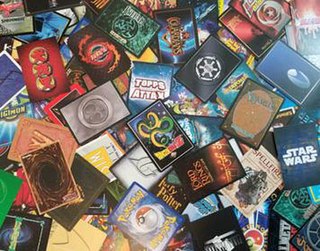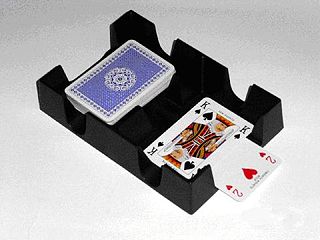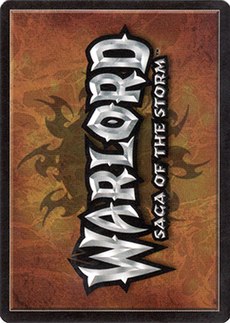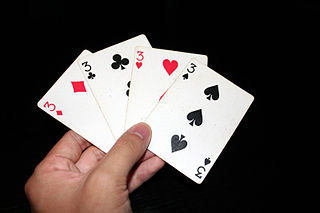| Color | Card Type | Sub-type | Qty. | Factions | Explanation |
|---|
| | Characters | Centauri | 57 | Babylon 5 Faction,
Home Faction,
Babylon Project Faction | A race geared for war with the Narn, heavy on Intrigue, There is a good portion of psi available. Diplomacy and leadership, although not their strong suit, are above average |
| | Characters | Drakh | 11 | None | You do not begin the game as a Drakh Faction, you must choose one of the five major Factions. You may then sponsor a Drakh Ambassador by a non Drakh character an immediately promote him to your Inner Circle and he becomes your new Ambassador. He cannot be targeted the card "Taunts and Games". Your previous Ambassador remains an Inner Circle character and can never be demoted. Drakh are opposed to Vorlon marks. Once you sponsor a Drakh Ambassador you are now a Drakh Faction but your Race remains as it was when you started. You also retain special designations such as Home Faction or Psi Corps. If your Drakh Ambassador leaves play you immediately lose the game. It cannot seek asylum. Drakh cards can only be sponsored by Drakh cards. Drakh use Chaos Tokens. After any action, a player may move any number of Chaos Tokens from one card to another. Drakh cannot have their racial loyalty change. The Drakh, as a race, cannot be targeted, named, or referred to in anyway by another card. |
| | Characters | Human | 102 | Babylon 5 Faction,
Home Faction,
Babylon Project Faction,
Psi Corps Faction | Evenly balanced in most abilities. Depending on which faction you use some may be stronger. The Psi Corps alternate faction has an extremely high psi pool of characters. Using the Home Faction will leave you dependent of intrigue which is of decent standing. The Humans leadership is somewhat evenly balanced depending which characters you use. |
| | Characters | Minbari | 58 | Babylon 5 Faction,
Home Faction,
Babylon Project Faction | Strong in Diplomacy and Leadership. Members of the Grey Council are quite strong. Any Warrior Caste character will increase greatly to a fleet it leads. |
| | Characters | Narn | 44 | Babylon 5 Faction,
Home Faction,
Babylon Project Faction | Heavily relies on Leadership, One of the weaker overall races. It has no Psi whatsoever. its Intrigue is quite weak. It does have above average Diplomacy. It makes up for its shortcomings with its aggressiveness. |
| | Characters | Neutral | 122 | None | A wide variety of characters available to all factions with a wide range of abilities. Specialty characters such as "Media", "Mercenaries", "Soulhunters" and "Techno-mages" can be found here. |
| | Characters | Non-Aligned | 47 | Abbai,
Brakiri,
Drazi,
Gaim,
Gnome,
Golian,
Hyach,
Ipsha,
Llort,
Markeb,
Pak'ma'ra,
Sh'lassan,
Vree,
Yolu | Although weak in abilities, they have a versatile group. With 16 different ambassadors to choose from, the various combinations seem endless. |
| | Characters | Shadow | 3 | None | Although this is a non starting race and you may not gain an ambassador, it is possible to construct a deck built around Shadow influence and gear it towards winning a Major Victory by starting the Shadow War. There are several Shadow characters as well Neutral characters to choose from that have Shadow influence. It is worth noting that if another player is using the Vorlons it is expected that a long drawn out battle may result. A Faction with Shadow marks cannot gain any Vorlon marks. Any card giving marks of such type is ignored. Raising the Shadow influence to 20 will begin the Shadow War where all players must then score a Major Victory. |
| | Characters | Vorlon | 12 | None | Like the Shadow, this is not a starting race and does not have a starting ambassador (even though Ambassador Kosh does exist in the game he cannot be used as a starting ambassador). Until the "Dream Set" Vorlon expansion was released online, the Shadows had a larger card pool selection to choose from making it slightly more advantageous for them. But if players agree to use these cards as proxies, then much balance is restored if not giving an upper hand to the Vorlons. A faction having Vorlon marks cannot gain Shadow marks. Any card giving them such type is ignored. Raising the Vorlon influence to 20 will begin the Shadow War where all players must then score a Major Victory. |
| | Groups | Neutral,
Race Specific | 51+
26 | N/A | Groups are Limited unless otherwise specified. Most have an effect on play. They are supporting cards and do not get promoted to the Inner Circle. If a race type is listed on the Group card the it is restricted to that race. |
| | Fleets | Neutral,
Race Specific,
Babylon 5,
United | 5+
89+
10+
3 | Set by Race,
Non-Aligned Specific,
Babylon 5,
Neutral | Fleets are a factions primary Military capability. they are limited unless otherwise noted. They are restricted to a particular race if noted on the card and cannot be promoted to the Inner Circle. |
| | Locations | Neutral,
Race Specific | 15+
27 | Varies | Locations offer a wide variety of benefits, most are race specific, and their military can only be used to oppose conflicts that target it. |
| | Enhancements | Neutral,
Race Specific,
Babylon 5 | 233+
31+
8 | N/A | Enhancements are cards that tend to benefit other cards although some are detrimental. Some enhancements are restricted to specific types of cards (characters, fleets, locations). Enhancements on captured Locations are discarded. Enhancements are not limited unless otherwise stated on the card itself but no two copies of the same enhancement may target the same card. This is true for the game itself, only one copy of a specific Global Enhancement may be in pay at any given time. Restricted enhancements which have a specific race listed on them must be sponsored by a member of that race and must also be placed on a card of that race or in a faction of that race. |
| | Agenda | Neutral,
Race Specific | 57+
33 | N/A | Agendas is the overall goal of your faction. They offer several benefits such as additional influence, power, and/or benefits to your faction. Some Agendas are race related. You may have only one Agenda in play at one time however you may rotate an Inner Circle character to sponsor a new one or bring one into play if you do not have one. Agendas may be brought into play hidden, these are called Hidden Agendas. They have no effect on play until revealed. It may be revealed as an action during the Action round where it then takes effect immediately. |
| | Agenda | Major | 13+
| N/A | Some Agendas are noted as Major Agendas as part of their card type. They cannot be discarded but may be replaced by other Major Agendas or by cards which specify you can. When you have a major Agenda in play you cannot score a Standard Victory. |
| | Events | Neutral,
Race Specific | 388+
20 | N/A | Event cards allow various effects to happen during the action round. The effects of Events are immediate unless specifically stated otherwise. Once an Event has expired it is discarded. |
| | Contingencies | Neutral,
Race Specific | 67+
3 | N/A | Contingency cards are played face down during the action round and only one can be played (unless otherwise stated). They are played in their players faction and they may be viewed by that player at any time. Each has a specific Trigger which activates the Contingency where its effect then is applied. Revealing a contingency is optional, therefore strategy can be a factor when holding back for a key moment prior to victory or to prevent another layer from claiming victory. If the effect of the contingency has expired place the card in the discard pile. |
| | Conflicts | Neutral,
Race Specific | 262+
11 | N/A | Each faction may normally initiate one conflict per turn. Conflicts are played during the Conflict round. Characters and fleets support or oppose conflicts of their choosing depending on how the outcome may affect their faction. A faction which receives more support wins the conflict and one which receives equal or more opposition loses the conflict. Conflicts with a race name on them are restricted to that race. |
| | Conflicts | Diplomacy | 94 | N/A | These conflicts will require the Diplomacy ability in most cases. They may in some instances allow another ability to be used if the card itself states on it to do so. |
| | Conflicts | Intrigue | 80 | N/A | These conflicts will require the Intrigue ability in most cases. They may in some instances allow another ability to be used if the card itself states on it to do so. |
| | Conflicts | Leadership | 8 | N/A | These conflicts will require the Leadership ability in most cases. They may in some instances allow another ability to be used if the card itself states on it to do so. |
| | Conflicts | Military | 38 | N/A | These conflicts will require the Military ability in most cases. They may in some instances allow another ability to be used if the card itself states on it to do so. |
| | Conflicts | Psi | 22 | N/A | These conflicts will require the Psi ability in most cases. They may in some instances allow another ability to be used if the card itself states on it to do so. |
| | Aftermaths | Neutral,
Race Specific | 189 | N/A | After the conflict resolution round, players may then play Aftermaths. Most Aftermaths act like enhancements modifying certain cards. Some take immediate effect. These effects are not reversed when the Aftermath is discarded. Only one Aftermath can affect a given target at any one time. If a race name appears on an Aftermath it can only be played by that race. |
| | Aftermaths | Won | 44 | N/A | These Aftermaths may be played on a conflict won by the initiator. |
| | Aftermaths | Lost | 67 | N/A | These aftermaths may be played on a conflict loss by the initiator. |
| | Aftermaths | Participant | 28 | N/A | These aftermaths may be played by anyone who participated in the targeted conflict. |
|












